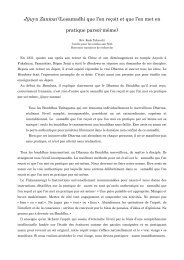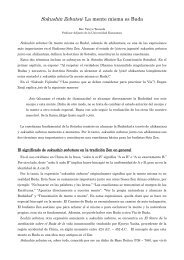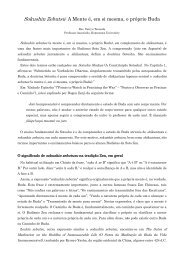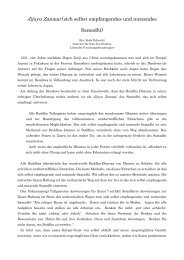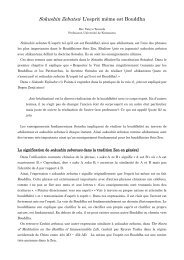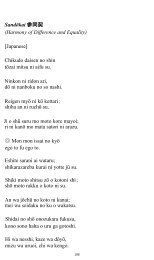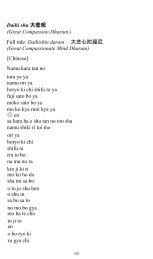Sokushin Zebutsu - sotozen-net
Sokushin Zebutsu - sotozen-net
Sokushin Zebutsu - sotozen-net
You also want an ePaper? Increase the reach of your titles
YUMPU automatically turns print PDFs into web optimized ePapers that Google loves.
More than anything else, sokushin zebutsu is famous as a saying of Baso Doitsu (709 ~ 788), wholived in the Tang Dynasty.<strong>Sokushin</strong> zebutsu and shikantazaDogen Zenji tells about Baso Doitsu’s sokushin zebutsu or sokushin sokubutsu in a jodo (talk) inthe Eihei Koroku.Baso said “<strong>Sokushin</strong> zebutsu.” Daibai studied this more than thirty years, dwelling on hismountaintop, hiding his traces in the sounds of the valley and the colors of the mountain. Theancestor Baso finally sent a monk to visit and say to Daibai, “Baso’s Buddha Dharma isdifferent these days.”Daibai responded, “How is it different?”The monk said, “Hishin hibutsu.” (no mind, no Buddha).Daibai said “Even if he says ‘No mind, no Buddha,’ I just follow sokushin zebutsu.”The monk returned and told the ancestor.Baso said, “That plum is ripe.”Dogen said “<strong>Sokushin</strong> zebutsu is most intimate. Year after year Daibai ripened in themiddle of summer.” (Eihei Koroku, vol. 1, no. 8)Daibai Hojo (752~839) understood the Buddha Way through the teaching of Baso’s sokushinzebutsu and retreated into the deep mountains for more than thirty years. He wholeheartedlypracticed sokushin zebutsu. He was not at all upset when a monk dispatched by Baso said, “Baso’sBuddha Dharma has recently changed from sokushin zebutsu to hishin hibutsu.” He said, “I do notcare about hishin hibutsu. I just follow solely sokushin zebutsu.” Upon hearing this statement, Basoadmired Daibai, saying, “A plum has ripened.”This episode featuring Daibai and Baso also appears in Eihei Koroku, vol. 4, no. 319. Interestingly,this jodo begins with the statement “The true Dharma correctly transmitted by buddhas andancestors is simply shikantaza.” Dogen introduces this statement as his late master Nyojo’sinstruction to the assembly. Here, the story is told in order to emphasize the importance of zazen(shikantaza). Dogen Zenji speaks of Daibai as a person who “ate pine nuts and wore lotus leaves,spending his whole life practicing zazen day and night.” The story is originally found in the “DaibaiHojo” chapter in the Record of the Transmission of the Lamp Published in the Jingde Era (KeitokuDentoroku, Taisho Tripitaka 51, p. 254 ff.). This source does not mention that Daibai practicedzazen in the mountains. Probably “spending his whole life practicing zazen” is Dogen’s personalreligious conviction. “I just follow sokushin sokubutsu” means nothing but shikantaza. Therefore itis not without reason that this phrase is paired with shikantaza in Sotoshu Shuken (Soto ShuConstitution).It is understandable that Dogen Zenji writes at the beginning of Shobogenzo “<strong>Sokushin</strong> <strong>Zebutsu</strong>,”“What buddhas and ancestors have maintained without exception is sokushin zebutsu.” It is suchan important phrase describing realization that it is perfectly all right to replace sokushin zebutsu


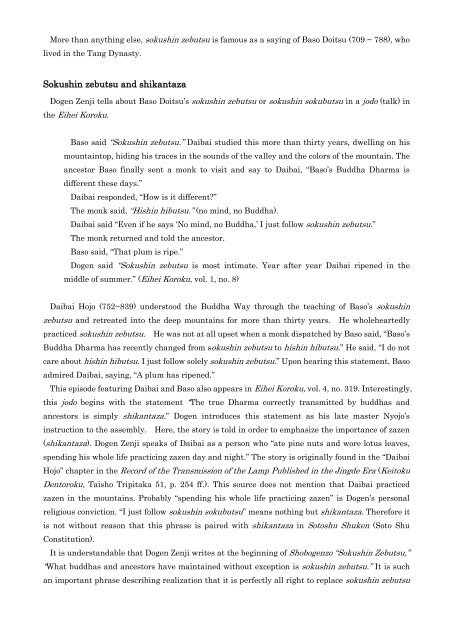
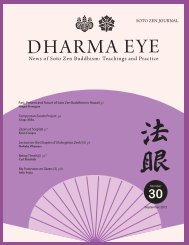

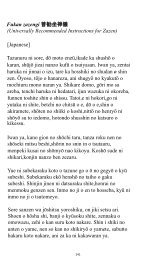

![(Daihishin darani 大æ²å¿éç¾
å°¼ï¼ [Chinese] - sotozen-net](https://img.yumpu.com/38648887/1/156x260/daihishin-darani-aaeaec-3-4-a-1-4-i-1-4-chinese-sotozen-net.jpg?quality=85)


